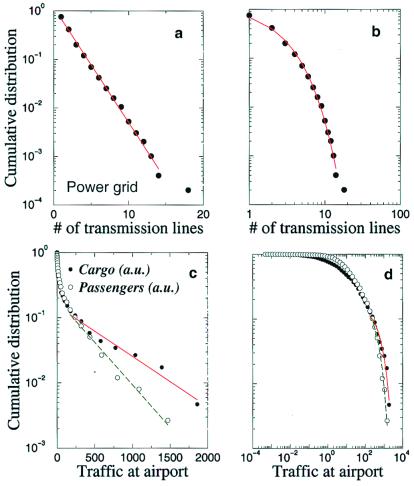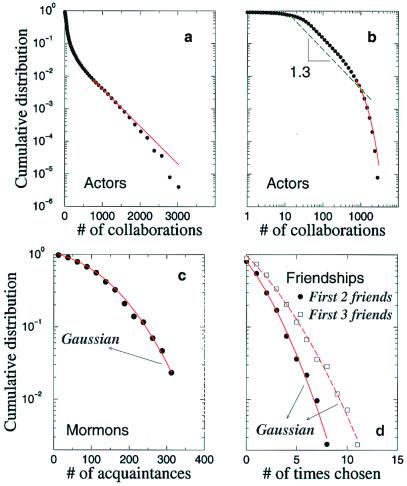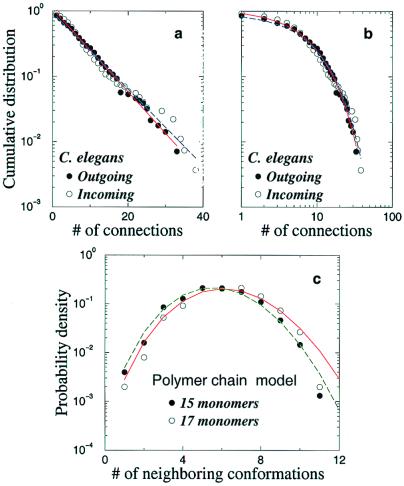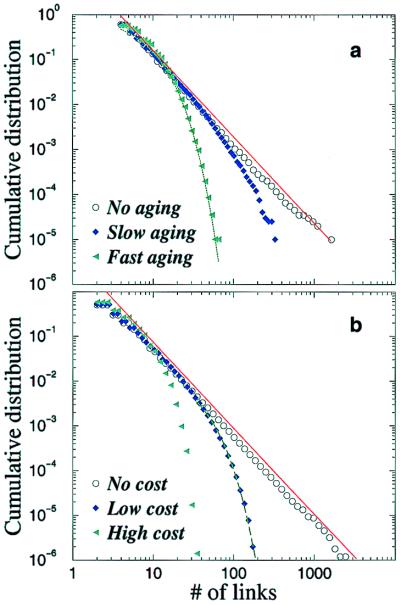Abstract
We study the statistical properties of a variety of diverse real-world networks. We present evidence of the occurrence of three classes of small-world networks: (a) scale-free networks, characterized by a vertex connectivity distribution that decays as a power law; (b) broad-scale networks, characterized by a connectivity distribution that has a power law regime followed by a sharp cutoff; and (c) single-scale networks, characterized by a connectivity distribution with a fast decaying tail. Moreover, we note for the classes of broad-scale and single-scale networks that there are constraints limiting the addition of new links. Our results suggest that the nature of such constraints may be the controlling factor for the emergence of different classes of networks.
Disordered networks, such as small-world networks are the focus of recent interest because of their potential as models for the interaction networks of complex systems (1–7). Specifically, neither random networks nor regular lattices seem to be an adequate framework within which to study “real-world” complex systems (8) such as chemical-reaction networks (9), neuronal networks (2), food webs (10–12), social networks (13, 14), scientific-collaboration networks (15), and computer networks (4, 16–19).
Small-world networks (2), which emerge as the result of randomly replacing a fraction P of the links of a d dimensional lattice with new random links, interpolate between the two limiting cases of a regular lattice (P = 0) and a random graph (P = 1). A small-world network is characterized by the following properties: (i) the local neighborhood is preserved (as for regular lattices; ref. 2); and (ii) the diameter of the network, quantified by average shortest distance between two vertices (20), increases logarithmically with the number of vertices n (as for random graphs; ref. 21). The latter property gives the name small-world to these networks, because it is possible to connect any two vertices in the network through just a few links, and the local connectivity would suggest the network to be of finite dimensionality.
The structure of small-world networks and of real networks has been probed through the calculation of their diameter as a function of network size (2). In particular, networks such as (a) the electric power grid for Southern California, (b) the network of movie-actor collaborations, and (c) the neuronal network of the worm Caenorhabditis elegans seem to be small-world networks (2). Further, it was proposed (5) that these three networks (a–c) as well as the world-wide web (4) and the network of citations of scientific papers (22, 23) are scale-free—that is, they have a distribution of connectivities that decays with a power law tail.
Scale-free networks emerge in the context of a growing network in which new vertices connect preferentially to the more highly connected vertices in the network (5). Scale-free networks are also small-world networks, because (i) they have clustering coefficients much larger than random networks (2) and (ii) their diameter increases logarithmically with the number of vertices n (5).
Herein, we address the question of the conditions under which disordered networks are scale-free through the analysis of several networks in social, economic, technological, biological, and physical systems. We identify a number of systems for which there is a single scale for the connectivity of the vertices. For all these networks, there are constraints limiting the addition of new links. Our results suggest that such constraints may be the controlling factor for the emergence of scale-free networks.
Empirical Results
First, we consider two examples of technological and economic networks: (i) the electric power grid of Southern California (2), the vertices being generators, transformers, and substations and the links being high-voltage transmission lines; and (ii) the network of world airports (24), the vertices being the airports and the links being nonstop connections. For the case of the airport network, we have access to data on number of passengers in transit and of cargo leaving or arriving at the airport, instead of data on the number of distinct connections. Working under some reasonable assumptions,‡ one can expect that the number of distinct connections from a major airports is proportional to the number of passengers in transit through that airport, making the two examples, i and ii, comparable. Fig. 1 shows the connectivity distribution for these two examples. It is visually apparent that neither case has a power law regime and that both have exponentially decaying tails, implying that there is a single scale for the connectivity k.
Figure 1.
Technological and economic networks. (a) Linear-log plot of the cumulative distribution of connectivities for the electric power grid of Southern California (2). For this type of plot, the distribution falls on a straight line, indicating an exponential decay of the distribution of connectivities. The full line, which is an exponential fit to the data, displays good agreement with the data. (b) Log-log plot of the cumulative distribution of connectivities for the electric power grid of Southern California. If the distribution would have a power law tail then it would fall on a straight line in a log-log plot. Clearly, the data reject the hypothesis of power law distribution for the connectivity. (c) Linear-log plot of the cumulative distribution of traffic at the world's largest airports for two measures of traffic, cargo, and number of passengers. The network of world airports is a small-world network; one can connect any two airports in the network by only one to five links. To study the distribution of connectivities of this network, we assume that, for a given airport, cargo and number of passengers are proportional to the number of connections of that airport with other airports. The data are consistent with a decay of the distribution of connectivities for the network of world airports that decays exponentially or faster. The full line is an exponential fit to the cargo data for values of traffic between 500 and 1,500. For values of traffic larger than 1,500, the distribution seems to decay even faster than an exponential. The long-dashed line is an exponential to the passenger data for values of traffic between 500 and 1,500. a.u., arbitrary units. (d) Log-log plot of the cumulative distribution of traffic at the world's largest airports. This plot confirms that the tails of the distributions decay faster than a power law would.
Second, we consider three examples of “social” networks: (iii) the movie-actor network (2), the links in this network indicating that the two actors were cast at least once in the same movie; (iv) the acquaintance network of Mormons (25), the vertices being 43 Utah Mormons and the number of links the number of other Mormons they know; and (v) the friendship network of 417 Madison Junior High School students (26). These three examples describe apparently distinct types of social networks with very different sample sizes. In fact it can be argued that the network of movie-actor collaborations is not really a social network but is instead an economic network. However, because it was considered in other publications (1, 2, 5) as a social network, we classify it similarly here. We feel that the acquaintance and friendship networks may be better proxies of real social networks and, as such, expect similar results from the analysis of both networks. Fig. 2 shows the connectivity distribution for these social networks. The scale-free (power law) behavior of the movie-actor network (5) is truncated by an exponential tail. In contrast, the network of acquaintances of the Utah Mormons and the friendship network of the high school students display no power law regime, but instead we find results consistent with a Gaussian distribution of connectivities, indicating the existence of a single scale for k.§
Figure 2.
Social networks. (a) Linear-log plot of the cumulative distribution of connectivities for the network of movie actors (2). The full line is a guide for the eye of what an exponential decay would be. The data seem to fall faster in the tail than they would for an exponential decay, suggesting a Gaussian decay. Both exponential and Gaussian decays indicate that the connectivity distribution is not scale-free. (b) Log-log plot of the cumulative distribution of connectivities for the network of movie actors. This plot suggests that, for values of number of collaborations between 30 and 300, the data are consistent with a power law decay. The apparent exponent of this cumulative distribution, α − 1 ≈ 1.3, is consistent with the value α = 2.3 ± 0.1 reported for the probability density function (5). For larger numbers of collaborations, the power law decay is truncated. (c) Linear-log plot of the cumulative distribution of connectivities for the network of acquaintances of 43 Utah Mormons (25). The full line is the fit to the cumulative distribution of a Gaussian. The tail of the distribution seems to fall off as a Gaussian, suggesting that there is a single scale for the number of acquaintances in social networks. (d) Linear-log plot of the cumulative distribution of connectivities for the friendship network of 417 high school students (26). The number of links is the number of times a student is chosen by another student as one of his/her two (or three) best friends. The lines are Gaussian fits to the empirical distributions.
Third, we consider two examples of networks from the natural sciences: (vi) the neuronal network of the worm C. elegans (2, 27, 28), the vertices being the individual neurons and the links being connections between neurons; and (vii) the conformation space of a lattice polymer chain (29), the vertices being the possible conformations of the polymer chain and the links being the possibility of connecting two conformations through local movements of the chain (29). The conformation space of a linear polymer chain seems to be well described (29) by the small-world networks of ref. 2. Fig. 3 a and b shows for C. elegans the cumulative distribution of k for both incoming and outgoing neuronal links. The tails of both distributions are well approximated by exponential decays, consistent with a single scale for the connectivities. For the network of conformations of a polymer chain, the connectivity follows a binomial distribution, which converges to the Gaussian (29); thus, we also find a single scale for the connectivity of the vertices (Fig. 3c).
Figure 3.
Biological and physical networks. (a) Linear-log plot of the cumulative distribution of outgoing (i.e., connections by axons to other cells) and incoming (i.e., connections by axons from other cells) connections for the neuronal network of the worm C. elegans (27, 28). The full and long-dashed lines are exponential fits to the distributions of outgoing and incoming connections, respectively. The tails of the distributions seem consistent with an exponential decay. (b) Log-log plot of the cumulative distribution of outgoing and incoming connections for the neuronal network of the worm C. elegans. If the distribution would have a power law tail, then it would fall on a straight line in a log-log plot. The data seem to reject the hypothesis of a power law distribution for the connectivity. (c) Linear-log plot of the probability density function of connectivities for the network of conformations of a lattice polymer chain (29). A simple argument suggests that the connectivities follow a binomial distribution. The full and dashed lines are fits of a binomial probability density function to the data for polymer chains of different lengths. For the values of the parameters obtained in the fit, the binomial closely resembles the Gaussian, indicating that there is a single scale for the connectivities of the conformation space of polymers.
Discussion
Thus far, we presented empirical evidence for the occurrence of three structural classes of small-world networks: (a) scale-free networks, characterized by a connectivity distribution with a tail that decays as a power law (4, 22, 23); (b) broad-scale or truncated scale-free networks, characterized by a connectivity distribution that has a power law regime followed by a sharp cutoff, like an exponential or Gaussian decay of the tail (see example iii); and (c) single-scale networks, characterized by a connectivity distribution with a fast decaying tail, such as exponential or Gaussian (see examples i, ii, and iv–vii).
A natural question is “what are the reasons for such a rich range of possible structures for small-world networks?” To answer this question, let us recall that preferential attachment in growing networks gives rise to a power law distribution of connectivities (5). However, preferential attachment can be hindered by two classes of factors.
Aging of the vertices.
This effect can be pictured for the network of actors; in time, every actor will stop acting. For the network, this fact implies that even a very highly connected vertex will, eventually, stop receiving new links. The vertex is still part of the network and contributes to network statistics, but it no longer receives links. The aging of the vertices thus limits the preferential attachment preventing a scale-free distribution of connectivities.
Cost of adding links to the vertices or the limited capacity of a vertex.
This effect is exemplified by the network of world airports: for reasons of efficiency, commercial airlines prefer to have a small number of hubs where all routes connect. In fact, this situation is, to a first approximation, indeed what happens for individual airlines; however, when we consider all airlines together, it becomes physically impossible for an airport to become a hub to all airlines. Because of space and time constraints, each airport will limit the number of landings/departures per hour and the number of passengers in transit. Hence, physical costs of adding links and limited capacity of a vertex (30, 31) will limit the number of possible links attaching to a given vertex.
Modeling.
To test numerically the effect of aging and cost constraints on the local structure of networks with preferential attachment, we simulate the scale-free model of ref. 5 but introduce aging and cost constraints of varying strength. In the original scale-free model, a network grows over time by the addition of new vertices and links. A vertex newly added to the network randomly selects m other vertices to establish new links, with a selection probability that increases with the number of links of the selected vertex. This mechanism generates faster growth of the most connected vertices—in a process identical to the city growth model of Simon and Bonini (32)—and it is well-known that the mechanism leads to a steady state with a power law distribution of connectivities (33).
We generalize this model by classifying vertices into one of two groups: active or inactive. Inactive vertices cannot receive new links. All new vertices are created active but in time may become inactive. We consider two types of constraints that are responsible for the transition from active to inactive. In the first, which we call “aging,” vertices may become inactive each time step with a constant probability Pi. This fact implies that the time a vertex may remain active decays exponentially. In the second, which we call “cost,” a vertex becomes inactive when it reaches a maximum number of links kmax. Fig. 4 shows our results for both types of constraint. It is clear that both lead to cutoffs on the power law decay of the tail of connectivity distribution and that, for strong enough constraints, no power law region is visible.
Figure 4.
Truncation of scale-free connectivity by adding constraints to the model of ref. 5. (a) Effect of aging of vertices on the connectivity distribution. We see that aging leads to a cutoff of the power law regime in the connectivity distribution. For sufficient aging of the vertices, the power law regime disappears altogether. (b) Effect of cost of adding links on the connectivity distribution. Our results indicate that the cost of adding links also leads to a cutoff of the power law regime in the connectivity distribution and that, for a sufficiently large cost, the power law regime disappears altogether.
Analogy with Critical Phenomena.
We note that the possible distributions of connectivity of the small-world networks have an analogy in the theory of critical phenomena (34). At the gas-liquid critical point, the distribution of sizes of the droplets of the gas (or of the liquid) is scale-free, as there is no free-energy cost in their formation (34). As for the case of a scale-free network, the size s of a droplet is power law distributed: P(s) ≈ s−α. As we move away from the critical point, the appearance of a non-negligible surface tension introduces a free-energy cost for droplets that limits their sizes such that their distribution becomes broad-scale: P(s) ≈ s−αf(s/ξ), where ξ is the typical size for which surface tension starts to be significant, and the function f(s/ξ) introduces a sharp cutoff for droplet sizes s > ξ. Far from the critical point, the scale ξ becomes so small that no power law regime is observed and the droplets become single-scale distributed: P(s) ≈ f(s/ξ). Often, the distribution of sizes in this regime is exponential or Gaussian.
Acknowledgments
We thank J. S. Andrade, Jr., R. Cuerno, N. Dokholyan, P. Gopikrishnan, C. Hartley, E. LaNave, K. B. Lauritsen, F. Liljeros, H. Orland, F. Starr, and S. Zapperi for stimulating discussions and helpful suggestions. The Center for Polymer Studies is funded by the National Science Foundation and National Institutes of Health (NCRR P41 RP13622).
Footnotes
To be able to compare the two types of distributions, one must make two assumptions. The first assumption is that there is a typical number of passengers per flight. This assumption is reasonable, because the number of seats in airplanes does not follow a power law distribution. The second assumption is that there is a typical number of flights per day between two cities. This assumption is also reasonable, because at most there will be about 20 flights per day and per airline between any two cities; thus, the distribution of number of flights per day between two cities is bounded.
Article published online before print: Proc. Natl. Acad. Sci. USA, 10.1073/pnas.200327197.
Article and publication date are at www.pnas.org/cgi/doi/10.1073/pnas.200327197
Note that even though the sample sizes of these two networks is rather small, the agreement with the Gaussian distribution is very good, suggesting that our results are reliable. Moreover, a power law distribution would curve the opposite way in the semilog plot.
References
- 1.Watts D J, Strogatz D H. Nature (London) 1998;393:440–442. doi: 10.1038/30918. [DOI] [PubMed] [Google Scholar]
- 2.Watts D J. Small Worlds: The Dynamics of Networks Between Order and Randomness. Princeton, NJ: Princeton Univ. Press; 1999. [Google Scholar]
- 3.Barthélémy M, Amaral L A N. Phys Rev Lett. 1999;82:3180–3183. [Google Scholar]
- 4.Albert R, Jeong H, Barabási A-L. Nature (London) 1999;401:130. [Google Scholar]
- 5.Barabási A-L, Albert R. Science. 1999;286:509–512. doi: 10.1126/science.286.5439.509. [DOI] [PubMed] [Google Scholar]
- 6.Lago-Fernandez L F, Huerta R, Corbacho F, Siguenza J A. Phys Rev Lett. 2000;84:2758–2761. doi: 10.1103/PhysRevLett.84.2758. [DOI] [PubMed] [Google Scholar]
- 7.Newman, M. E. J. (2000) J. Stat. Phys., in press.
- 8.Kochen M, editor. The Small World. Norwood, NJ: Ablex; 1989. [Google Scholar]
- 9.Alon U, Surette M G, Barkai N, Leibler S. Nature (London) 1999;397:168–171. doi: 10.1038/16483. [DOI] [PubMed] [Google Scholar]
- 10.Pimm S L, Lawton J H, Cohen J E. Nature (London) 1991;350:669–674. [Google Scholar]
- 11.Paine R T. Nature (London) 1992;355:73–75. [Google Scholar]
- 12.McCann K, Hastings A, Huxel G R. Nature (London) 1998;395:794–798. [Google Scholar]
- 13.Wasserman S, Faust K. Social Network Analysis. Cambridge, U.K.: Cambridge Univ. Press; 1994. [Google Scholar]
- 14.Axtell R. In: Behavioral Dimensions of Retirement Economics. Aaron H J, editor. Washington, DC: Brookings Instit.; 1999. pp. 161–183. [Google Scholar]
- 15.Van Raan A F J. Nature (London) 1990;347:626. [Google Scholar]
- 16.Adamic L A. The Small World Web Res Adv Tech Digit Libr Proc. 1999;1696:443–452. [Google Scholar]
- 17.Huberman B A, Pirolli P L T, Pitkow J E, Lukose R J. Science. 1999;280:95–97. doi: 10.1126/science.280.5360.95. [DOI] [PubMed] [Google Scholar]
- 18.Huberman B A, Adamic L A. Nature (London) 1999;401:131. [Google Scholar]
- 19.Adamic L A, Huberman B A, Barabási A-L, Albert R, Jeong H, Bianconi G. Science. 2000;287:2115. [Google Scholar]
- 20.van Leeuwen J, editor. Handbook of Theoretical Computer Science. Volume A: Algorithms and Complexity. Amsterdam: Elsevier; 1999. [Google Scholar]
- 21.Bollobás B. Random Graphs. London: Academic; 1985. [Google Scholar]
- 22.Seglen P O. J Am Soc Inf Sci. 1992;43:628–638. [Google Scholar]
- 23.Redner S. Eur Phys J. 1998;4:131–134. [Google Scholar]
- 24.Airport Council International. ACI Annual Worldwide Airports Traffic Reports. Geneva: Airport Counc. Int.; 1999. [Google Scholar]
- 25.Bernard H R, Kilworth P D, Evans M J, McCarty C, Selley G A. Ethnology. 1988;27:155–179. [Google Scholar]
- 26.Fararo T J, Sunshine M H. A Study of a Biased Friendship Net. Syracuse, NY: Syracuse Univ. Press; 1964. [Google Scholar]
- 27.White J G, Southgate E, Thomson J N, Brenner S. Philos Trans R Soc London B. 1986;314:1–340. doi: 10.1098/rstb.1986.0056. [DOI] [PubMed] [Google Scholar]
- 28.Koch C, Laurent G. Science. 1999;284:96–98. doi: 10.1126/science.284.5411.96. [DOI] [PubMed] [Google Scholar]
- 29.Scala A, Amaral L A N, Barthélémy M. Small-World Networks and the Conformation Space of a Lattice Polymer Chain. cond-mat/0004380; 1999. [Google Scholar]
- 30.Bonney M E. In: Sociometry and the Science of Man. Moreno J L, editor. New York: Beacon House; 1956. pp. 275–286. [Google Scholar]
- 31.Moreno J L. Sociometry and the Science of Man. New York: Beacon House; 1956. [Google Scholar]
- 32.Simon H A, Bonini C P. Am Econ Rev. 1958;48:607–617. [Google Scholar]
- 33.Ijiri Y, Simon H A. Skew Distributions and the Sizes of Business Firms. Amsterdam: North–Holland; 1977. [Google Scholar]
- 34.Stanley H E. Introduction to Phase Transitions and Critical Phenomena. Oxford: Oxford Univ. Press; 1971. [Google Scholar]






